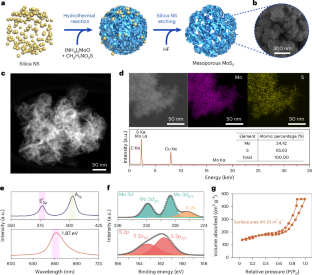介孔结构 MoS2 作为电子传输层用于高效稳定的过氧化物太阳能电池
IF 38.1
1区 材料科学
Q1 MATERIALS SCIENCE, MULTIDISCIPLINARY
引用次数: 0
摘要
过氧化物太阳能电池(PSCs)中的介孔结构电子传输层(ETLs)增加了与过氧化物层的表面接触,从而实现了有效的电荷分离和萃取以及高效设备。然而,PSC 中最广泛使用的 ETL 材料 TiO2 需要 500 °C 以上的烧结温度,并且在入射光下会发生光催化反应,从而限制了运行稳定性。最近,人们致力于寻找替代 ETL 材料,如二氧化锡。在此,我们提出介孔 MoS2 作为一种高效稳定的 ETL 材料。MoS2 夹层增加了与相邻过氧化物层的表面接触面积,改善了两层之间的电荷转移动力学。此外,与二氧化钛相比,MoS2 和过氧化物晶格之间的匹配有利于低残余应变过氧化物晶体的优先生长。利用介孔结构 MoS2 作为 ETL,我们获得了效率分别为 25.7% (0.08 平方厘米,认证为 25.4%)和 22.4% (1.00 平方厘米)的 PSC。在连续光照条件下,我们的电池可保持稳定 2,000 小时以上,这表明与 TiO2 相比,我们的电池具有更好的光稳定性。本文章由计算机程序翻译,如有差异,请以英文原文为准。


Mesoporous structured MoS2 as an electron transport layer for efficient and stable perovskite solar cells
Mesoporous structured electron transport layers (ETLs) in perovskite solar cells (PSCs) have an increased surface contact with the perovskite layer, enabling effective charge separation and extraction, and high-efficiency devices. However, the most widely used ETL material in PSCs, TiO2, requires a sintering temperature of more than 500 °C and undergoes photocatalytic reaction under incident illumination that limits operational stability. Recent efforts have focused on finding alternative ETL materials, such as SnO2. Here we propose mesoporous MoS2 as an efficient and stable ETL material. The MoS2 interlayer increases the surface contact area with the adjacent perovskite layer, improving charge transfer dynamics between the two layers. In addition, the matching between the MoS2 and the perovskite lattices facilitates preferential growth of perovskite crystals with low residual strain, compared with TiO2. Using mesoporous structured MoS2 as ETL, we obtain PSCs with 25.7% (0.08 cm2, certified 25.4%) and 22.4% (1.00 cm2) efficiencies. Under continuous illumination, our cell remains stable for more than 2,000 h, demonstrating improved photostability with respect to TiO2. Mesoporous MoS2 is proposed as an efficient electron transport layer in perovskite solar cells, achieving efficiencies >25% with over 2,000 h of stable operation.
求助全文
通过发布文献求助,成功后即可免费获取论文全文。
去求助
来源期刊

Nature nanotechnology
工程技术-材料科学:综合
CiteScore
59.70
自引率
0.80%
发文量
196
审稿时长
4-8 weeks
期刊介绍:
Nature Nanotechnology is a prestigious journal that publishes high-quality papers in various areas of nanoscience and nanotechnology. The journal focuses on the design, characterization, and production of structures, devices, and systems that manipulate and control materials at atomic, molecular, and macromolecular scales. It encompasses both bottom-up and top-down approaches, as well as their combinations.
Furthermore, Nature Nanotechnology fosters the exchange of ideas among researchers from diverse disciplines such as chemistry, physics, material science, biomedical research, engineering, and more. It promotes collaboration at the forefront of this multidisciplinary field. The journal covers a wide range of topics, from fundamental research in physics, chemistry, and biology, including computational work and simulations, to the development of innovative devices and technologies for various industrial sectors such as information technology, medicine, manufacturing, high-performance materials, energy, and environmental technologies. It includes coverage of organic, inorganic, and hybrid materials.
 求助内容:
求助内容: 应助结果提醒方式:
应助结果提醒方式:


